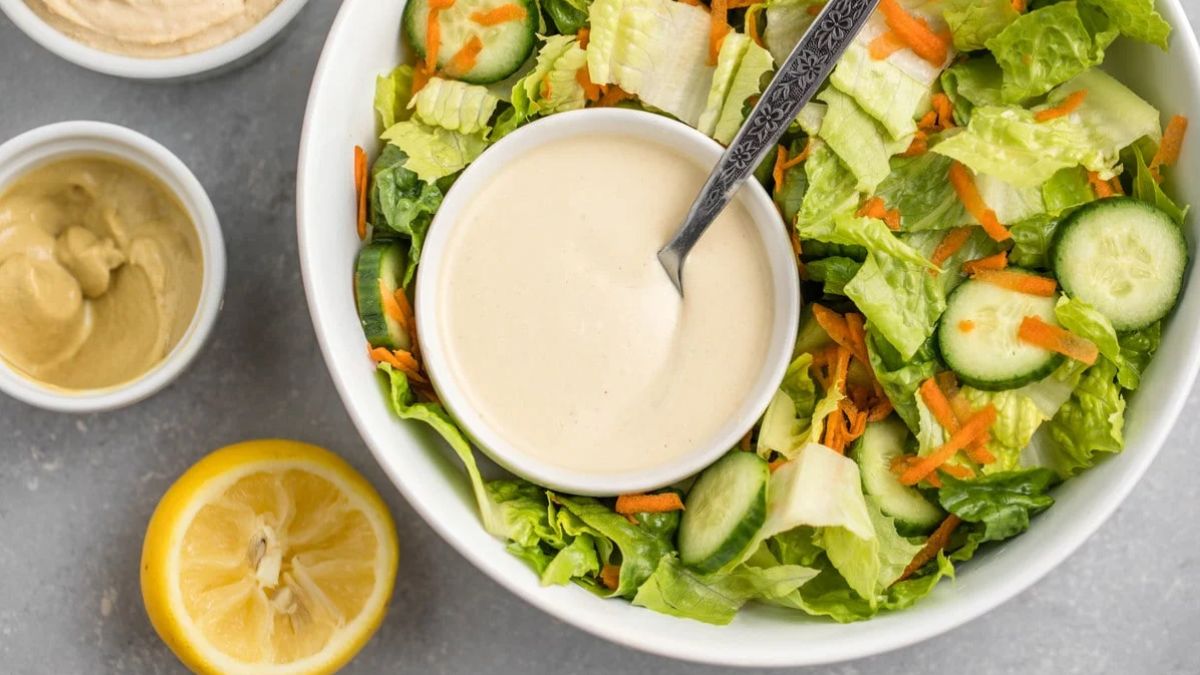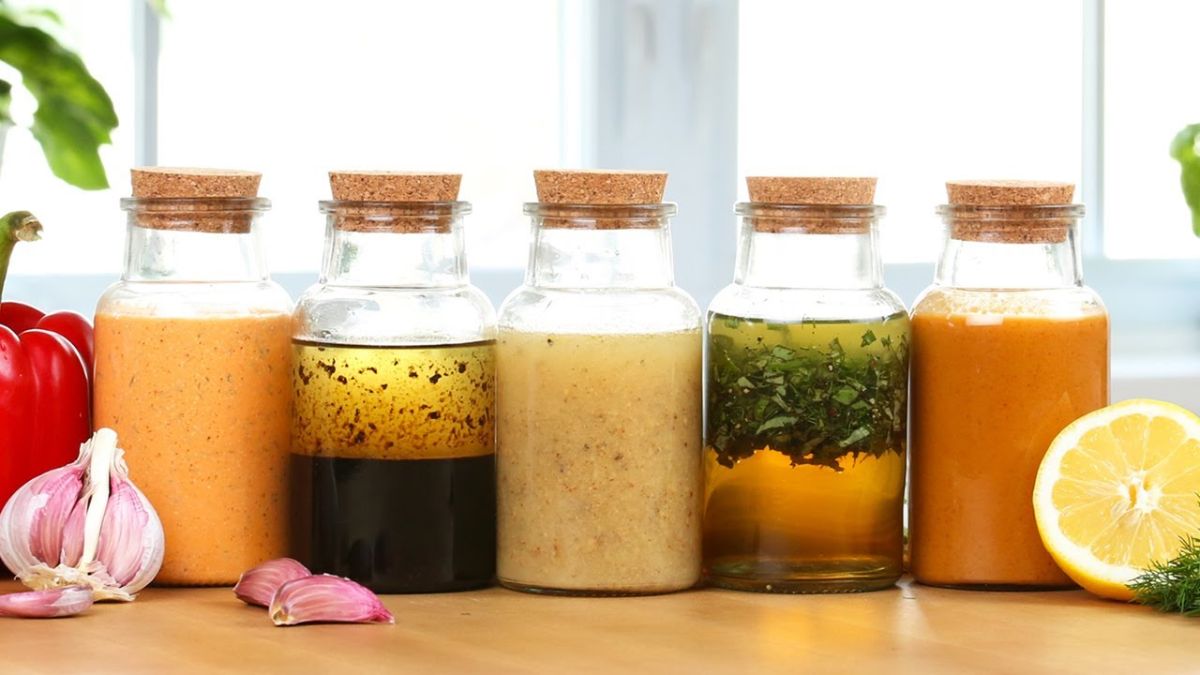Make your salad dressing at home to make a more excellent salad. You’ll get a better-tasting, healthier salad by avoiding store-bought salad dressings, but you’ll also save money. We’ve picked up our favorite, easy, tasty salad dressings that will make your greens and fresh vegetables sing, whether you prefer a basic Caesar salad, try your hand at vinaigrettes, or want something more culturally inspired. Balsamic vinegar is a healthy food additive low in natural sugar and fat, and it has been shown to decrease cholesterol and maintain blood pressure.
According to some research, it may also help as an appetite suppressant, containing probiotic bacteria types. A coddled egg was once used to make Caesar salad dressing. However, implementing it in this manner is simply borrowing trouble. For starters, it’s an additional step. However, if the egg is overcooked, the dressing will be challenging to emulsify. It’s easier to use raw egg yolks, and since that’s how most Caesar salads are made these days, it’ll turn out just how you remember. If you’re worried about eating raw eggs, use pasteurized eggs.
Best Salad Dressing Recipes
Here Are The Best Ten Salad Dressing Recipes
1. Warm Bacon Dressing
A substantial salad is always a welcome addition when serving a steak supper with all the trimmings. Warm bacon dressing is an excellent option for these times, and it holds up well against sturdy spinach or kale leaves. The heated dressing wilts the greens, giving them a wonderful, soft texture and a strip of delicious smoky bacon.
2. Greek Salad Dressing
A typical Greek salad dressing can be made with only four ingredients. Shake it up in a mason jar and garnish basic “village salads” of tomato, cucumber, red onion, lettuce, black olives, and feta cheese. Leftover dressing can be kept in the fridge for two weeks in the same jar.
3. Caesar Salad Dressing
Whether you serve it alongside heartier fare or top it with chicken or shrimp for a lighter main course at lunch or dinner, Caesar salad is always a winner. This traditional Caesar dressing recipe will earn you a reputation as a salad master.
4. Elderflower Vinegar
This unique recipe can make gorgeous vinegar for spring and summer salads. Elderflower liqueur changes simple vinaigrette components with its sweet, pleasant, floral flavor. It’s clever to make a beautiful salad in minutes with very little work.
5. Balsamic Salad Dressing
Make your classic balsamic vinaigrette instead of buying store-bought. It’s one of the simplest and quickest dressings to make, and it gives mild greens a delightfully tangy, somewhat sweet flavor. Dijon mustard functions as an emulsifier, allowing the oil and vinegar to bind together for a creamier dressing.
6. Homemade Thousand Island Dressing Recipe
Thousand island dressing is a 1950s traditional salad dressing for chopped iceberg lettuce. With this simple recipe with all the classic salad dressing flavors you desire, everyone can enjoy its creamy, tangy sweetness. Also works well as a topping for vegetable burgers.
7. Simple Italian Salad Dressing
This straightforward Italian dressing employs a straightforward method for generating a wonderfully emulsified vinaigrette. When shaken, the tiny dash of Dijon keeps the oil and vinegar blended for a restaurant-quality salad dressing.
8. Korean Gochujang Vinaigrette
Gochujang, or fermented red chili paste, is a popular Korean condiment with delicious spicy, sweet, and savory flavors. To make a palate-tingling vinaigrette-style dressing for salad greens, cold soba noodles, or cooked shrimp, combine it with a few other Asian ingredients.
9. Creamy Blue Cheese Salad Dressing
Making your blue cheese dressing is simple. It is less expensive, but you also have more options for selecting fantastic blue cheeses, such as gorgonzola or Roquefort. Serve it as a beautiful dip for Buffalo chicken wings or fresh coat greens.
10. Japanese Onion, Ginger, and Carrot Salad Dressing
This Japanese-style dressing is flavorful, thick, and simple to make in the food processor. It provides an excellent, modern, Asian-inspired topping for cool iceberg lettuce. Pureed vegetables and ginger offer plenty of nutrients and a pleasantly thick texture, while ketchup and soy sauce create a fantastic sweet and tangy taste.
What is Balsamic Vinegar?
Balsamic vinegar is prepared from the must of unfermented sweet white Trebbiano grapes. Natural balsamic vinegar is matured for at least ten years, just like wine, and must meet specific criteria. And Balsamic vinegar that has been aged for 50 years is the best. Genuine balsamic vinegar is dark brown and syrupy, with honey, fig, raisins, and caramel notes. This product is only for deep pockets, just like delicious wine.
Now for the goods, you’re more likely to locate them on grocery store shelves and utilize them. Although the label will claim “balsamic vinegar,” this is considered imitation commercial-grade balsamic vinegar. There are no standards for this vinegar. It contains apple cider vinegar, white vinegar, wine vinegar, sugar, caramel, and flavorings. Because it does not include grapes, it has not matured. It is inexpensive. However, this very inexpensive faux balsamic vinegar is acceptable for dressings because it is combined with other components. In a pinch, you can make a workable balsamic vinegar replacement.
What are the Different Types of Blue Cheese?
What are the Other Uses for Italian Dressing?
This excellent salad dressing can also be used for the following:
- Add homemade Italian dressing to potato or pasta salad to make it shine. Combine your preferred veggies, black olives, chopped sundried tomatoes, sliced red onions, and a couple of teaspoons of capers with cooked short pasta, farro, quinoa, or rice. Dress with the combination, a few teaspoons of mayonnaise, and a squeeze of lime for a tart kick.
- Before roasting or grilling, marinate meat, pig, or seafood. Marinate haddock steaks in the dressing for 10 minutes for a lovely and straightforward fish meal. Depending on the thickness of the fillets, bake en papillote for 10 to 16 minutes at 400°F.
- To make a fantastic crudité and chip dip, combine four tablespoons of the dressing with 8 ounces of cream cheese.
- Drizzle the dressing over a round of ricotta, Brie, or Camembert baked-on store-bought puff pastry before cutting.
How to Make Homemade Thousand Island Dressing Recipe?
Thousand Island dressing is a salad dressing and a condiment that is, frankly, mayonnaise dressed up with whatever is available. It’s a kind of uber-condiment with numerous varieties. It may contain onions, sweet pickle relish, ketchup, Worcestershire sauce, hard-boiled egg, bell peppers, parsley, green olives, pimento, garlic chives, and even nuts in addition to mayonnaise. It also has an exciting name and history, with conflicting origin claims dating back to the late 1800s. While the exact details may never be known, the land is from the United States Upper Midwest region.
Steps to Make It
- Gather the ingredients.
- Add all ingredients to a medium bowl and lightly whisk to combine.
Ingredients
- 1 cup mayonnaise (homemade or store-bought)
- Two tablespoons ketchup
- One tablespoon of onion powder
- One teaspoon sugar
- 1/2 teaspoon paprika
- 1/2 teaspoon Dijon mustard
Optional Add-Ins:
- Two tablespoons of finely chopped onion
- One tablespoon of sweet pickle relish
- One tablespoon of finely chopped pimento
- 1/2 teaspoon crushed red peppers
Tips
- A food processor, micro food processor, or blender are all necessary pieces of equipment.
- Serve with burgers, Reuben sandwiches, and a variety of salads. It’s also a fantastic dip for French fries.
- Refrigerate for up to two months in a tightly sealed jar.
How to Make Japanese Onion, Ginger, and Carrot Salad Dressing?
Salad dressings in Japan, such as this ginger, onion, and carrot dressing, are distinctive. They frequently use a puree of vegetables and other ingredients to create a fresh, tasty dressing. Wafu dressing, which translates to “Japanese-style dressing,” is their name.
A soy sauce-based dressing and a tomato paste-based dressing are two famous widespread homemade Japanese salad dressings. Soy sauce-based salad dressings tend to be lighter than tomato paste-based dressings, as the latter thickens the dressing naturally and adds a depth of richness that soy sauce-based salads lack.
Steps to Make it
- Gather the ingredients.
- In a food processor, combine the yellow onion and carrot. (A blender could also be used.)
- Ginger should be peeled and minced before being added to a food processor.
- Pulse or combine the ketchup (or tomato paste), soy sauce, canola oil, rice vinegar, and salt in a food processor until smooth and blended.
- Taste the dressing and season with a pinch of black pepper and a pinch of white sugar, if preferred.
- For best results, chill the dressing for 1 to 2 hours before serving.
Ingredients
- 1/4 cup chopped yellow onion
- 1/4 cup chopped carrot (about one small carrot)
- 1/2 teaspoon minced ginger
- Two tablespoons of ketchup or tomato paste
- One tablespoon of soy sauce
- 1/2 cup canola oil
- 1/4 cup rice vinegar
- 1/2 teaspoon salt (to taste)
- Optional: a dash of black pepper
- Optional: 1/2 teaspoon granulated white sugar
Tips
- A food processor, micro food processor, or blender are all necessary pieces of equipment.
- The dressing for this Japanese onion, ginger, and carrot salad is made with tomatoes, but instead of tomato paste, we used ketchup. If you have tomato paste in your cupboard, give it an e which you prefer. We discovered that the tomato paste had a little more acid, resulting in a tarter dressing.
- The key ingredients in the salad dressing are three veggies, yellow onion, ginger, and carrots, which are the critical ingredients in the salad dressing. In a food processor (or blender), purée the veggies until smooth, then combine with soy sauce, rice vinegar, ketchup, and oil. We recommend using a mild-flavored oil like canola, vegetable, or coconut oil, but feel free to use anything you choose, dressing with a pinch of salt and pepper. You’ve got yourself a quick and flavorful salad dressing.
- The raw onion puree provides a pleasant spiciness to this salad dressing, while the tastes of the carrots and ginger balance it out. It’s preferable if you chill it first.
- This dressing can also be used as a meat or fish marinade.
Conclusion
A vinaigrette, such as balsamic or oil and vinegar, is the healthiest salad dressing, but Caesar, ranch, or anything containing “creamy” is the unhealthiest. Vinaigrette, emulsified vinaigrette, mayonnaise-based, and mayonnaise are the four primary salad dressings. The persistent merging of different components, such as oil and vinegar, is an emulsion. Vinaigrettes are milder dressings for delicate components such as salad greens. Preparation. Vinegar, sugar or honey, milk or cream, eggs or egg yolks, salt, mustard, cayenne pepper, and flour are frequent ingredients in the boiled dressing. The dressing is occasionally boiled, but it is typically gradually simmered in a double boiler over boiling water.

